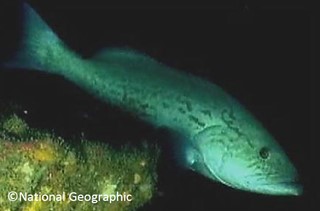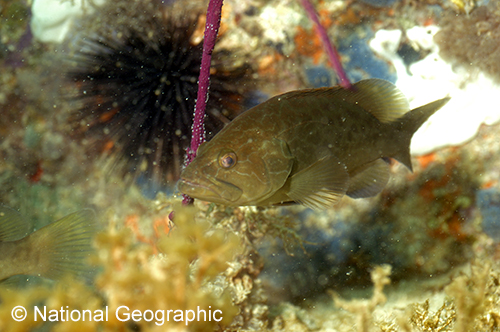Fast Facts: Adult & Juvenile Gag
Description

Gag, Mycteroperca microlepis, are ecologically and economically important reef fishes that are distinguished by their worm-like markings, both as adults and juveniles. They are often recognized by the slight concavity in their tails, notably different from the square tail of a black grouper (Mycteroperca bonaci). They also have dark fins with white margins on both the anal and caudal fins. They can reach lengths of 58 inches (1.5 m) and weigh up to 81 pounds (37 kg).
 Habitat
Habitat
Gag are the most widely distributed of all of the Western Atlantic groupers and are found from North Carolina to Brazil. In the Gulf of Mexico, juveniles are found in seagrass meadows primarily along the West Florida Shelf. As adults, they inhabit rocky ledges and reefs at depths ranging from 60 to 500 feet (18 to 152 meters) deep.
Reproduction
As protogynous hermaphrodites, gag first mature as females and later a portion of the population transforms into males, typically after the spawning season. The time of spawning differs throughout their range. Off the coast of the Carolinas, spawning takes place in February whereas in the Gulf of Mexico it occurs from January through March. Usually, gag will form large aggregations when spawning. Males stay on these sites year round, while females move to shallower water once the spawning season is over.

Threats
One major threat gag face is a vulnerability to catch. They are highly prized both commercially and recreationally and are targeted by fisherman especially when they aggregate to spawn (unfortunately for them, they are quite tasty). This aggregation fishing leads to a greater loss of males for several reasons. Males tend to stay on aggregation sites year round (which females do not do), take bait more aggressively than females do, and thus are preferentially removed from populations.
Conservation
While it is legal to harvest gag, they are protected in several ways. First, they are protected by size limits. The law mandates a 27 inch (69 cm) TL size limit and a three grouper per person bag limit, with no more than one fish in the bag being a gag. Second, they are protected by an annual seasonal closure, occurring from January 1st through April 30th, when it is illegal to catch them. Third, they are protected in marine reserves along the West Florida Shelf, the Madison Swanson Marine Reserve, and the Steamboat Lumps Marine Reserve. While it is important that we all maintain the privilege of fishing, it is also important to recognize that fish populations need to be protected so that fishing is sustainable.

